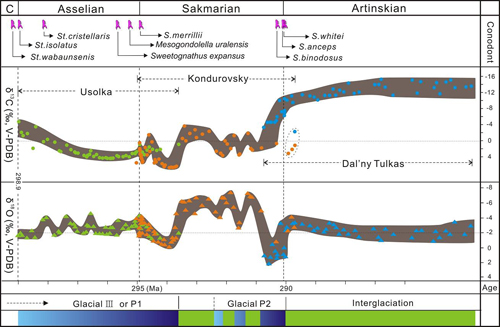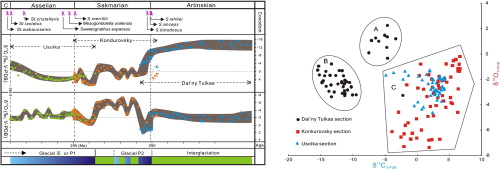摘要:乌拉尔统是二叠纪地层研究相对比较薄弱的时段,尽管国际地层委员会二叠纪地层分会早就将俄罗斯乌拉尔地区的乌拉尔统作为早二叠世的年代地层单位标准,但地层学的各方面研究进展缓慢。同时早二叠世也是地质历史中由冰室向温室效应转变的重大气候变化时期,但这次大冰期的沉积记录主要分布在南半球的冈瓦纳地区,是否在全球范围内有影响是一个长期争论的问题。
为此,中国科学院南京地质古生物研究所曾俊博士等在南乌拉尔地区三条GSSP的候选层型剖面高密度采集碳酸盐岩样品的基础上,进行了碳同位素分析,建立了完整的乌拉尔统Asselian阶到Artinskian阶的碳酸盐岩碳同位素(δ13C)变化过程,为乌拉尔地区GSSP候选剖面与其它地区剖面进行对比提供了化学地层学的依据。同时,碳、氧同位素在早二叠世表现出了一定的同步变化关系,可能代表了晚古生代冰期-间冰期气候变化对碳循环的影响。将南方高纬度地区的冰川事件和北半球中低纬度的碳、氧同位素变化联系起来,并且利用最新的生物地层和同位素年龄资料对碳、氧同位素的变化进行精确的时间控制,重新厘定了早二叠世冰期和间冰期的时代划分。
该成果即将发表在Gondwana Research上。

俄罗斯乌拉尔地区乌拉尔统碳同位素变化与古气候演化的关系
生物探索推荐英文论文摘要:
Carbon isotope chemostratigraphy and implications of palaeoclimatic changes during the Cisuralian (Early Permian) in the southern Urals, Russia
Abstract
In order to meet the requirements for potential GSSPs in the Cisuralian Series (Early Permian), isotopic chemostratigraphy from the Carboniferous/Permian boundary to middle Artinskian using bulk carbonates was investigated under high-resolution biostratigraphical and new geochronologic constrains from three GSSP candidate sections at Usolka, Kondurovsky and Dal'ny Tulkas in the southern Urals, Russia. A gradually increasing trend in carbonate carbon isotope (δ13C) has been observed in the interval from the base of Asselian to early Sakmarian, which is generally consistent in timing with the increasing development of Glacial III or P1 from the latest Carboniferous to early Sakmarian (Early Permian) which prevailed in southern Gondwana. An excursion with double negative shifts in δ13C value is present around the Asselian/Sakmarian boundary in both the Usolka and Kondurovsky sections, which may have great potential to serve as chemostratigraphical marks for intercontinental correlation. The following highly positive excursion of δ13C in early Sakmarian indicates the maximium expansion of Glacial III or P1. The negative δ13C shift in the middle Sakmarian is possibly related to the quick collapse of Glacial III or P1 on the Gondwanaland. This negative shift is largely correlative with those documented in other areas of Russia, the North American Craton and South China, but further precise biostratigraphical and geochronologic constrains are neccessary to confirm this global signal. The late Sakmarian is characterized by a strong oscillation stage of δ13C, which probably indicates a complex climate transition marked by smaller alternating glacial–interglacial transitions during Glacial P2 superimposed on an overall warming trend. The sharp negative δ13C shift around the Sakmarian/Artinskian boundary at the Dal'ny Tulkus section is difficult to interpret. This is followed by long-term low values (<−10‰) during the most part of Artinskian Stage. We suggest that the deeply depleted δ13C values in the Artinskian at the Dal'ny Tulkas section might result regionally from the enhanced input of organic carbon after the melt-out of ice sheets and the subsequent degradation and isotopic refractionation of the microbial chemosynthetic processes on the buried organic matter.
Graphical abstract

Research highlights
► New biostratigraphically and geochronologically well-controlled Cisuralian (Early Permian) carbon isotope chemostratigraphy. ► Potential chemostratigraphic marks for global correlation. ► Concurrent carbon and oxygen isotope excursions suggest a temporal link with the waxing and waning of glaciation on the Gondwanaland.
Keywords: Carbon isotope; Cisuralian; Glaciation; Isotope geochemistry; Permian; Urals







